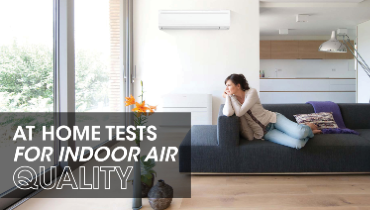
If you or anyone in your family has allergies, it’s more important than ever to maintain clean indoor air. Before you take action to improve air quality, you must know what problems currently exist. While you might need professional testing eventually, start with at-home air quality test kits to generate some initial findings.
Knowing how to test air quality in your home is the first step to creating a healthier living environment. Air quality testing can identify harmful pollutants like mold spores, radon, and volatile organic compounds (VOCs) that can affect your well-being.
Recognizing Signs of Poor Indoor Air Quality
If you’re unsure whether it’s time to test your home air quality, there are telltale signs that your indoor environment might need attention.
Physical Symptoms
Poor IAQ can manifest in various health issues:
- Allergies that seem worse indoors than outdoors
- Frequent headaches or dizziness
- Persistent coughing, sneezing, or nasal irritation
- Worsening of asthma symptoms or difficulty breathing
Environmental Indicators
Look out for these signs in your home:
- Persistent odors, such as a musty or chemical smell
- Visible mold growth on walls, ceilings, or vents
- An unexplained increase in dust accumulation or dirt around vents
- High humidity levels, often accompanied by condensation on windows
Recognizing these signs is critical, as it informs the need to check indoor air quality through reliable methods.
Simple Ways to Test Air Quality at Home
If you’re wondering how to check air quality in your home, there are simple and cost-effective ways to start:
DIY Home Air Quality Test Kits
At-home air quality test kits identify specific pollutants such as mold, radon, and VOCs. These kits provide initial insights, allowing you to decide whether further testing or remediation is necessary. Testing home air quality can be done with equipment readily available at hardware stores or online.
Air Quality Testing for Mold
With the right indoor air quality testing equipment, you can discover whether your home is a breeding ground for harmful mold.
The HVAC air filter or ductwork is the perfect place to test for mold growth. Here’s how:
- Dampen a sterile sponge with a rinse solution and wipe a section of the air filter or supply duct vent.
- Place the sponge in a rinse container and pour more solution over it.
- Shake the rinse container and pour the contents into a sample cup.
- Compare the color of the solution to the chart that came with your test kit. This tells you whether mold is growing on your air filter or in the ductwork.
Air Quality Testing for Radon
For quick results, conduct a short-term test, which only takes three to seven days to complete. Simply set out the test container, which is filled with granular activated charcoal that absorbs radon from the air. After a few days, seal the container and mail it to a lab for analysis.
A long-term test provides more accurate results, but the testing period lasts anywhere from eight days to one year. The test unit contains a piece of film that records the impacts of alpha particles and polonium, which are byproducts of decaying radon. The results from a lab analysis give you a thorough understanding of your radon exposure.
Air Quality Testing for VOCs
Indoor air quality testing equipment is available to analyze your exposure to volatile organic compounds. One such kit involves wearing a VOC-detecting badge for 24 hours to measure your personal exposure level. Send the badge to a lab for analysis, and when the results are mailed back, you’ll find out whether the concentration of VOCs in your home exceeds the permitted exposure levels.
Common Indoor Pollutants and Their Sources
Understanding the pollutants in your home helps you take targeted action.
Volatile Organic Compounds (VOCs)
VOCs are chemicals off-gassed by everyday household items. Many homes have dangerously high levels of formaldehyde, xylene, benzene, chloroform, styrene, and other toxic VOCs. Overexposure can cause everything from headaches and nasal irritation to liver damage and cancer.
Mold Spores
Mold thrives in damp areas like basements, bathrooms, and HVAC systems. Mold exposure can irritate allergies and worsen asthma symptoms.
Radon
As the leading cause of lung cancer among non-smokers, radon is a colorless, odorless gas that rises from the soil beneath your home as a result of uranium breaking down. You can test the radon levels in your home with an at-home air quality test kit.
Steps to Improve Indoor Air Quality
Once you’ve conducted tests and identified pollutants, follow these steps to improve your home’s air:
Increase Ventilation
Open windows regularly to allow fresh air circulation, especially during mild weather. Use exhaust fans in kitchens and bathrooms to reduce moisture and odors.
Use Air Purifiers
Invest in HEPA air purifiers to capture dust, allergens, and VOCs. Make sure to choose a purifier appropriate for your room size and specific needs.
Control Humidity Levels
Keep indoor humidity between 30-50% to prevent mold growth. Use dehumidifiers in damp areas and fix leaks promptly.
Regular Maintenance
Change your HVAC filters every two or three months. Clean air ducts periodically to ensure proper airflow. Also, opt for low-emission furniture and building materials to minimize VOC exposure.
When to Call in the Experts for Air Quality Testing
If DIY testing reveals elevated levels of pollutants or you experience persistent health symptoms, it’s time to call in professionals.
Why Professional Testing Matters
- Experts use advanced equipment to detect specific contaminants.
- They provide detailed reports outlining pollutant levels and possible solutions.
- Their recommendations are tailored to your home’s unique environment, ensuring the best outcomes.
Aire Serv offers comprehensive air quality testing services. With their help, you’ll gain the knowledge and tools needed to eliminate pollutants and maintain a healthier indoor environment.
Keeping Your Home’s Air Clean and Healthy
While at-home air quality testing is useful for identifying whether you have a problem, it isn’t enough. You might not know what to do with the results of your tests, or you could even end up with a false reading.
To ensure the best outcome, count on Aire Serv® to professionally test the air quality in your home and verify the findings from your DIY tests. After checking for mold, radon, and VOCs, we’ll help you determine which steps you should take to clean up your indoor air so you can breathe easy. Contact Aire Serv today to get in touch with a professional air quality expert!

